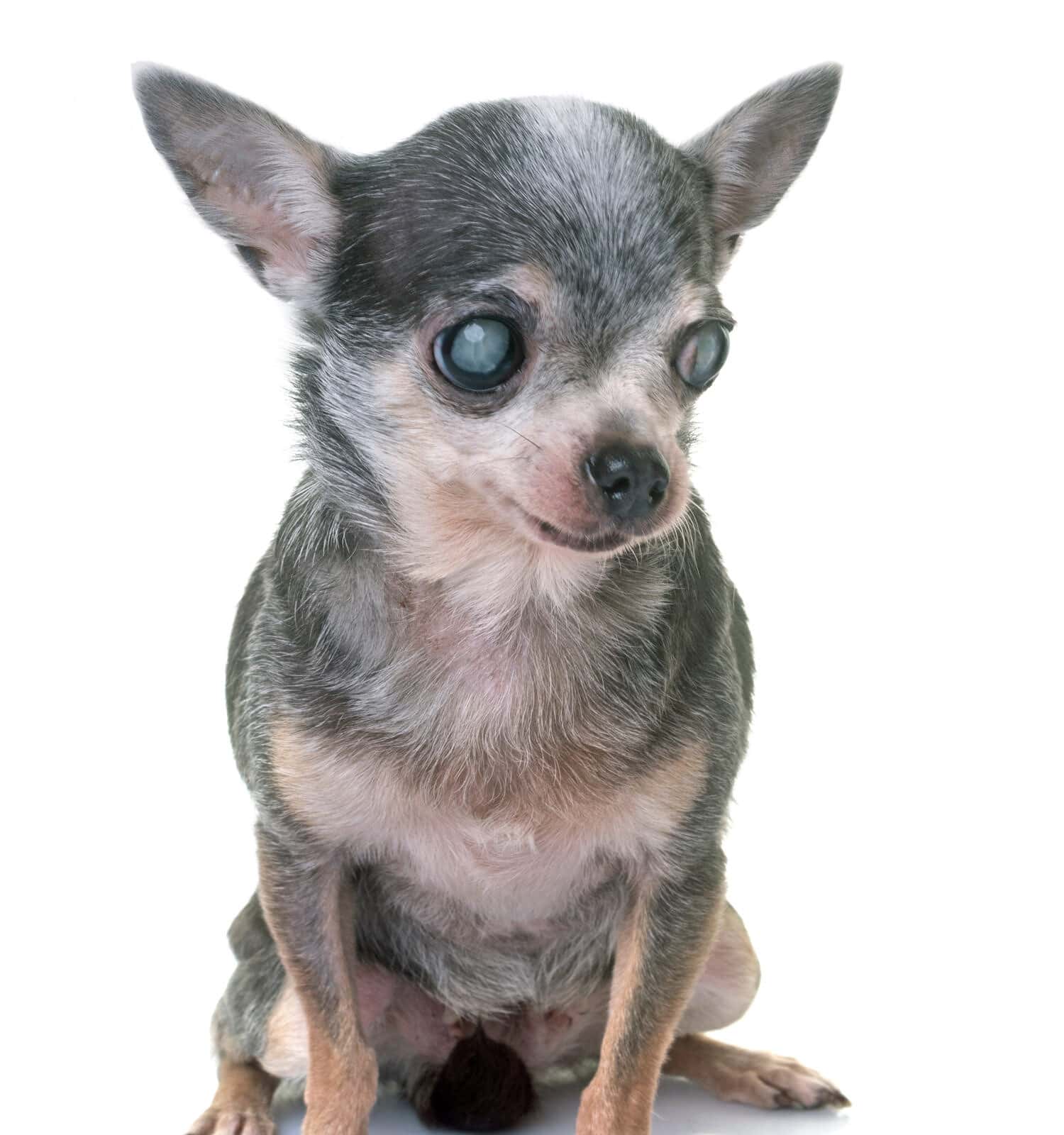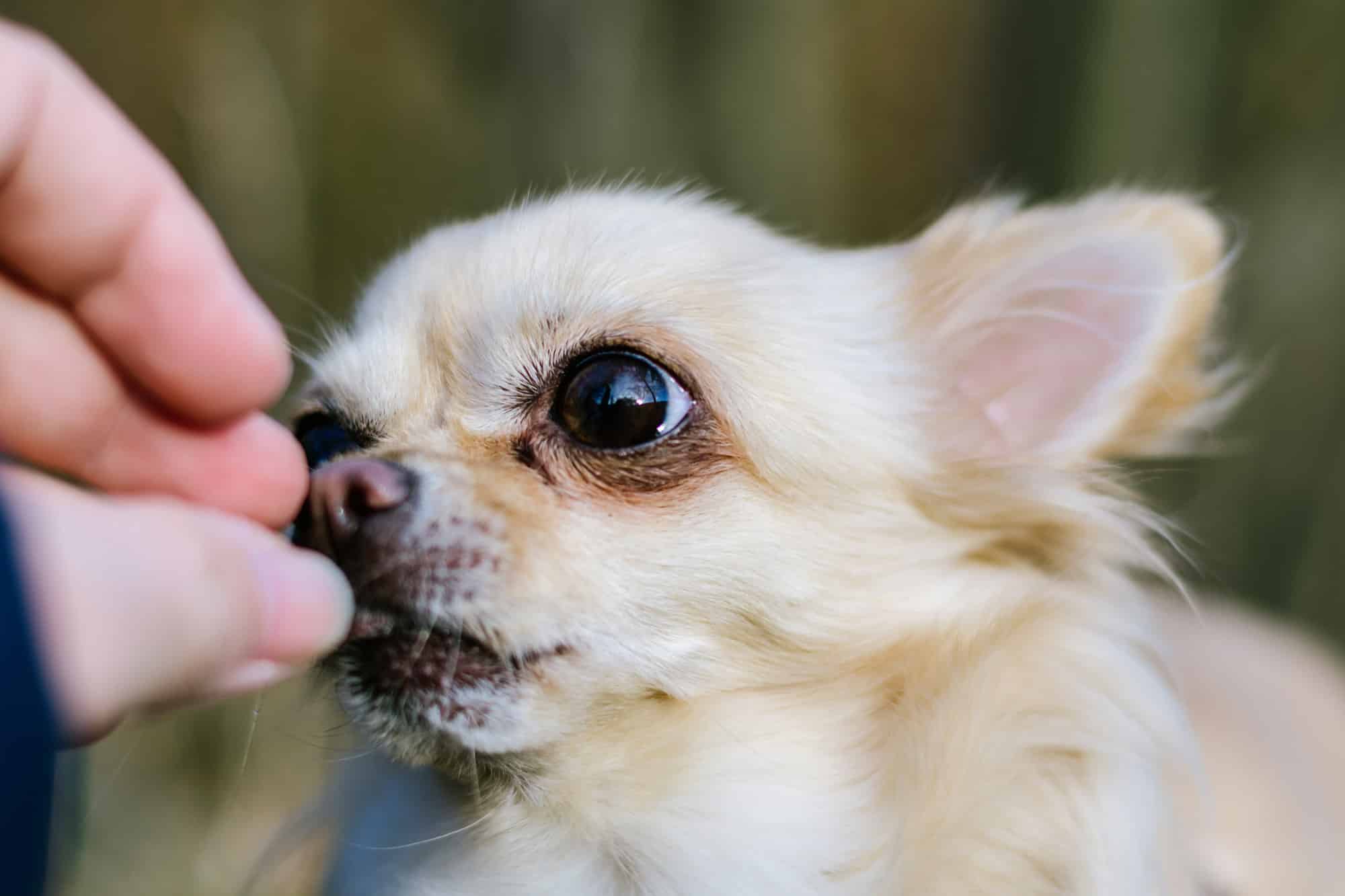When it comes to small dogs with big personalities, Chihuahuas take the crown. Originating from the northern Mexican state of the same name, this toy dog breed is one of the smallest in the dog kingdom. Don’t let their small size fool you. Chihuahuas have a notoriously big personality!
Despite their tiny stature, these lively and affectionate pets can face some specific health issues. In this article, we will shed light on the most common health problems found in Chihuahuas, offering guidance to help keep your pint-sized friend happy and healthy for years to come.
1. Luxating Patella

Nearly a quarter of all Chihuahuas experience a luxating patella, which can have a severe impact on their quality of life.
©MirasWonderland/Shutterstock.com
A slipping kneecap, or luxating patella, is one of the health problems that small dog breeds like the Chihuahua face. This problem might be due to their genes and can show up when the dog is still very young, even at four months. Surprisingly, research indicates that about 23% of Chihuahuas will face this health issue at some point in their lives.
The condition of a luxating patella is categorized into four grades, from mild to severe. In most instances, the kneecap deviates from its original position, hindering the Chihuahua’s ability to move around freely without experiencing pain. When the kneecap becomes permanently displaced, it can lead to constant discomfort, preventing your pet from utilizing the affected leg to its full extent.
Management strategies can be effective, especially if your Chihuahua is at grade 1 or 2 of the condition. It might involve closely monitoring their weight to prevent additional stress on the joints, preventing them from leaping from elevated surfaces, and ensuring that they receive optimal nutrition to support joint health.
Surgical intervention might become necessary for Chihuahuas experiencing a severe level of the condition, graded at 3 or 4.
2. Glaucoma

Glaucoma can cause vision loss and even blindness in Chihuahuas.
©cynoclub/Shutterstock.com
Chihuahuas are sadly prone to several severe eye problems, including glaucoma. This specific issue develops when the pressure inside the eye, known as intraocular pressure (IOP), increases. This increased pressure occurs because of a poor flow of a crucial fluid that brings oxygen to various areas of the eye.
This situation frequently stems from genetic factors, where inherited irregularities affect the drainage angle of the eye. A significant genetic trait called Goniodysgenesis makes Chihuahuas more likely to develop a type of glaucoma known as closed-angle glaucoma.
There are many medicines out there to help treat glaucoma, including several drug types like hyperosmotics and beta-blockers, among others. These drugs help manage the disease as much as possible, providing comfort and stopping it from getting worse.
3. Tracheal Collapse

Tracheal collapse is a serious health problem that can make breathing difficult for your Chihuahua.
©iStock.com/Aime Martin
Another common health problem with Chihuahuas is tracheal collapse. This breed often has a weaker windpipe structure compared to other dog breeds. This weakness can cause the cartilage rings in the windpipe to weaken or even collapse, making it difficult for the dog to breathe.
Though the exact cause of this issue isn’t fully understood, it seems to come from a mix of different factors. There might even be a genetic component since smaller breeds are usually more impacted.
To treat a collapsing windpipe in Chihuahuas, vets might use medical treatments, surgeries, or a combination of both, depending on how serious the condition is. They can provide necessary care, such as an oxygen tank to help your dog breathe easier.
However, it’s important for dog owners to know that Chihuahuas with this condition might need ongoing medical care, possibly for their whole life, even after surgery.
4. Hydrocephalus

A semi-common disease in Chihuahuas that causes swelling of the brain is hydrocephalus, which can be very difficult to fix.
©AppleDK/Shutterstock.com
Hydrocephalus, a medical term that means “water on the brain,” is a condition where excess fluid builds up inside the skull, causing the brain to swell. Chihuahuas, known for their small size and round heads, may be more likely to get this condition, which can be very hard or even impossible to fix.
If a Chihuahua is facing a severe case of hydrocephalus, there are several ways to treat it. Depending on what your pet needs, the vet might suggest different medications to reduce swelling and prevent seizures, including furosemide, acetazolamide, or omeprazole.
Additionally, in some cases, surgery to place a ventriculoperitoneal shunt might be an option to help relieve the symptoms.
5. Dental and Gum Disease

Chihuahuas, like most other dog breeds, are prone to issues in their teeth and gums. Proper dental care is very important.
©Chang-Pooh24/Shutterstock.com
Dental problems and gum diseases are sadly prevalent in many dog species. An astonishing 80 percent of dogs start showing signs of mouth problems by the time they reach 2 years of age, and Chihuahuas are no exception. Just as with people, the buildup of plaque and tartar on a dog’s teeth can really harm their gums. But this issue is not just about looks; it can worsen and lead to painful infections that can seriously affect your Chihuahua’s well-being.
The causes include not taking care of their teeth properly, genetic factors, issues with how their teeth line up, and the shape of a dog’s mouth.
Luckily, gum disease isn’t life-threatening. If you manage the health problem and take care of your Chihuahua’s teeth, the worst symptoms can be avoided. Regular teeth cleaning at home is an excellent way to keep the disease in check. Also, depending on the severity of your pet’s teeth, your vet might suggest specific treatments and medicines to fight infection or reduce inflammation, helping to lessen pain and swelling.
6. Heart Disease

The most common cause of death in Chihuahuas, especially older dogs, is heart disease.
©iStock.com/Jan Rozehnal
Heart failure, predominantly triggered by issues with the valves, is a leading cause of mortality in small dog breeds, including Chihuahuas. This common health problem in Chihuahuas occurs when a valve interferes with the regular flow of blood to the heart, posing a significant risk as any disruption in blood circulation can potentially be fatal.
In most cases, heart disease in dogs is not congenital but develops over time. Approximately 95% of canine heart diseases are acquired, typically due to the natural aging process affecting the heart’s condition, though sometimes it can result from injuries or infections. Chronic valvular disease (CVD), representing 70-75% of heart disease cases in dogs, is the most frequent heart condition affecting them.
To help manage heart disease, a range of medications might be recommended by your veterinarian to manage symptoms. Medicines such as beta-blockers, nitroglycerine, and digitalis are commonly used. In addition, a diuretic might be prescribed to address the buildup of fluid around the lungs, aiding in maintaining a comfortable and healthy life for your Chihuahua.
7. Intervertebral Disc Disease (IVDD)

In extreme cases, IVDD can cause full or partial paralysis in Chihuahuas.
©iStock.com/Irina Nedikova
IVDD, or Intervertebral Disc Disease, is a medical issue seen in dogs where the discs that serve as cushions between the spinal column’s bones protrude or rupture, encroaching upon the space between the spinal cord. This displacement can lead to various problems, including discomfort, nerve impairment, and, in severe instances, paralysis.
This disease stands as the leading reason behind spinal discomfort in Chihuahuas, affecting individuals of every age, though it mainly occurs in older Chihuahuas. The primary cause of IVDD is significant external force or gradual wear and tear over the years.
IVDD surgery is often seen as the most effective, and sometimes the only, solution for dogs experiencing serious IVDD. This surgery aims to remove the harmed or unhealthy disc material, easing the strain on your dog’s spine, ensuring proper blood circulation, and preventing future issues with the discs.
8. Chronic Bronchitis

If your Chihuahua suffers from pulmonary disease, you may need treatment and antibiotics.
©MODMOD/Shutterstock.com
Small dog breeds like the Chihuahua are more at risk of chronic obstructive pulmonary disease, which is also known as chronic bronchitis or, informally, asthma. This health problem begins with the small passageways in the lower respiratory tract becoming inflamed. As it develops further, it can lead to scarring in the lungs and enlarged air passages.
During the advanced phases of this illness, a Chihuahua might make a wheezing sound while breathing out and have difficulties catching breath or even faint.
The exact reason behind chronic bronchitis in dogs remains unclear; no specific cause has been identified. However, it is suspected that being around environmental irritants for an extended period could be a contributing factor. Dogs suffering from this condition have highly sensitive respiratory tracts.
Addressing mild to moderate stages of chronic bronchitis can involve inhalers, medications to widen the airways, and substances to control coughing. If a lung infection is detected, antibiotics might be necessary. Giving oxygen or administering medicine directly into the veins could be essential in extreme situations.
9. Open Fontanel

Despite being prone to several health conditions, Chihuahuas are one of the longest-living dog breeds.
©Natalivideo/Shutterstock.com
Chihuahua owners need to be on the lookout for a health issue known as open fontanel, known by soft areas on the top of a dog’s head. These soft spots occur due to the incomplete fusion of the skull bones while the dog is still growing. While many dogs with this condition can have a normal lifespan, they should maintain a calmer lifestyle. This prevents any potential head injuries, as even a minor accident could result in severe damage.
In the case of Chihuahuas, open fontanels that don’t close are usually a result of genetic irregularities affecting the usual skull development process. This condition might also pave the way for another serious ailment called hydrocephalus. Therefore, discussing with your veterinarian about the diagnostic process and strategies to keep your tiny furry friend healthy and happy for the long term is essential.
Currently, there isn’t a remedy or treatment for open fontanels. Nevertheless, we strongly recommend that dogs displaying signs of open fontanels should not be involved in breeding to prevent passing on the condition to future generations.
10. Bladder and Kidney Stones

Take good care of your Chihuahua and bring it to the vet if you notice your dog is acting strange.
©Benevolente82/Shutterstock.com
In older Chihuahuas, particularly males, it’s common to encounter issues like kidney and bladder stones. Three primary forms of stones often plague this breed, namely calcium oxalate, urate, and struvite stones. Interestingly, struvite stones are usually a consequence of infections.
The exact process that triggers the formation of these stones remains somewhat elusive to researchers. However, many veterinarians speculate that a diet rich in proteins and minerals might enhance the salt concentrations in a dog’s urine, thus facilitating stone development.
Addressing the problem of bladder and kidney stones often requires surgical intervention. There are instances where a procedure known as interventional radiology comes into play. Although it is common for stones to be passed naturally, keeping a vigilant eye on your Chihuahua is essential.
How to Take Care of Your Chihuahua

Chihuahuas are one of the most popular dog breeds in the world, with millions in the USA alone.
©otsphoto/Shutterstock.com
The best way to ensure your pet has a long, happy, and healthy life is to take good care of it. While you won’t be able to fully prevent all health problems in your Chihuahua, you will be able to catch these conditions early on with proper care. Here are some of our top recommendations for your Chihuahua’s diet, exercise, health, and training.
Diet
- Opt for premium dry dog food with a protein content between 30-33%.
- Limit salt in their diet to safeguard their heart and kidneys.
- For food suggestions, consult your veterinarian or a trusted Chihuahua breeder.
- Watch portions to keep obesity at bay. Refer to the feeding guidelines on the food package.
- Be cautious; even small amounts of table food can lead to health issues.
- Avoid harmful foods like bacon, chocolate, grapes, onions, and dairy.
- Chihuahuas have small stomach sizes, requiring frequent meals. Adjust the feeding frequency based on their size.
Exercise and Play
- They love activity in short spurts. Gentle walks using a harness are ideal.
- Arrange playful interactions, like fetch, and provide water during outdoor activities.
- Once socialized, occasional dog park visits can be beneficial.
Training
- Consider puppy kindergarten classes for young Chihuahuas for better interaction skills.
- Enroll adult Chihuahuas in obedience courses to learn commands and improve social interactions.
- Consistency is key. Take them outside routinely, especially after meals and before sleep.
- Provide a consistent set of rules to guide behavior.
- Early exposure to varied environments, sounds, and people ensures a balanced adult dog.
Health
- Regularly administer vet-recommended deworming medication.
- Ensure vaccinations for common diseases are up-to-date.
- Consider spaying or neutering to prevent unwanted litters and enhance health.
- Stay vigilant for health concerns like kneecap issues, neurological conditions, and breathing problems.
Summary of Common Health Problems Seen in Chihuahuas
| Number | Health Problem | Symptoms |
|---|---|---|
| 1. | Luxating Patella | Hopping, skipping, changes in walking, and leg stiffness |
| 2. | Glaucoma | Eye rubbing, watery discharge, and dilated pupil |
| 3. | Tracheal Collapse | Persistent dry cough and wheezing noise when breathing in |
| 4. | Hydrocephalus | Coma, vision loss, seizures, lethargy, and walking in circles |
| 5. | Dental and Gum Disease | Inflamed and bleeding gums, bad breath, and missing teeth |
| 6. | Heart Disease | Fainting, collapsing, breathing difficulty, and lack of energy |
| 7. | Intervertebral Disc Disease (IVDD) | Inability to walk, trembling or shaking, and knuckling on paws |
| 8. | Chronic Bronchitis | Persistent cough and lethargic behavior |
| 9. | Open Fontanel | Hole or soft spot in the skull |
| 10. | Bladder and Kidney Stones | Abdominal discomfort, blood in urine, and difficulty urinating |
The photo featured at the top of this post is © AppleDK/Shutterstock.com
Ready to discover the top 10 cutest dog breeds in the entire world?
How about the fastest dogs, the largest dogs and those that are -- quite frankly -- just the kindest dogs on the planet? Each day, AZ Animals sends out lists just like this to our thousands of email subscribers. And the best part? It's FREE. Join today by entering your email below.
Thank you for reading! Have some feedback for us? Contact the AZ Animals editorial team.







